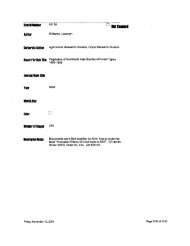Chapter 2: The Military Use of Herbicides in Vietnam - Special ...
Chapter 2: The Military Use of Herbicides in Vietnam - Special ...
Chapter 2: The Military Use of Herbicides in Vietnam - Special ...
You also want an ePaper? Increase the reach of your titles
YUMPU automatically turns print PDFs into web optimized ePapers that Google loves.
1. Each <strong>of</strong> the 11 different companies that manufactured military<br />
herbicides packed them <strong>in</strong> new ICC 17C 208-liter 18 gauge steel drums for<br />
shipment to Southeast Asia. Until 1967, l<strong>in</strong>ed drums were used only for<br />
shipment <strong>of</strong> Blue. However, because <strong>of</strong> the results <strong>of</strong> compatibility tests,<br />
l<strong>in</strong>ed drums were also used to ship White beg<strong>in</strong>n<strong>in</strong>g <strong>in</strong> 1967.<br />
2. Each herbicide drum was marked with a 7.6 cm color-coded band<br />
around the center to identify the specific military herbicide. This mark<strong>in</strong>g<br />
was <strong>in</strong>itially a 30 cm band, but was changed to a 7.6 cm band <strong>in</strong> March 1966.<br />
3. Shipp<strong>in</strong>g time from the arrival <strong>of</strong> the herbicide at a US port<br />
until it arrived <strong>in</strong> South <strong>Vietnam</strong> varied from 47 to 52 days.<br />
4. About 10 out <strong>of</strong> every 10,000 drums shipped were received <strong>in</strong> a<br />
damaged or defective state. This represented a damage rate <strong>of</strong> 0.1 percent.<br />
About 50 percent <strong>of</strong> these damaged drums leaked as a result <strong>of</strong> punctures or<br />
split seams. <strong>The</strong>se were caused by improper load<strong>in</strong>g and defective drums.<br />
Forklifts operated by stevedores also caused punctures. Redrumm<strong>in</strong>g was<br />
accomplished at the ports.<br />
5. About 65 percent <strong>of</strong> the herbicide was shipped to the 20th<br />
Ordnance Storage Depot, Saigon, and 35 percent was shipped to the 511th<br />
Ordnance Storage Depot, Da Nang. Under the normal handl<strong>in</strong>g procedures,<br />
drums were unloaded at Da Kang and Saigon from the cargo vessel directly<br />
<strong>in</strong>to semi-trailers and were placed <strong>in</strong> an upright position. <strong>The</strong> trailers<br />
were driven to the various units <strong>of</strong> the 12th Air Commando Squadron<br />
(primarily at the bases <strong>of</strong> Da Nang, Phu Cat, or Bien Hoa) for disposition.<br />
6. Normally the contents <strong>of</strong> the drums were transferred <strong>in</strong>to<br />
blocked F-6 trailer tanks through a suction tube without remov<strong>in</strong>g the full<br />
drums from the semi-trailers. Each F-6 trailer held 16,300 liters or about<br />
78 drums <strong>of</strong> herbicide. If blocked F-6 trailer tanks could not accomodate<br />
the total <strong>in</strong>ventory, the drums were stacked <strong>in</strong> pyramidal style until<br />
needed.<br />
11
















